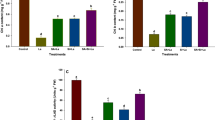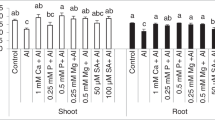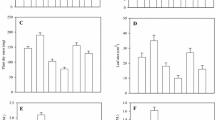Abstract
In the present study, ameliorating role of hydrogen sulfide (H2S) in oilseed rape (Brassica napus L.) was studied with or without application of H2S donor sodium hydrosulfide (NaHS) (0.3 mM) in hydroponic conditions under three levels (0, 0.1 and 0.3 mM) of aluminum (Al). Results showed that addition of H2S significantly improved the plant growth, photosynthetic gas exchange, and nutrients concentration in the leaves and roots of B. napus plants under Al stress. Exogenously applied H2S significantly lowered the Al concentration in different plant parts, and reduced the production of malondialdehyde and reactive oxygen species by improving antioxidant enzyme activities in the leaves and roots under Al stress. Moreover, the present study indicated that exogenously applied H2S improved the cell structure and displayed clean mesophyll and root tip cells. The chloroplast with well-developed thylakoid membranes could be observed in the micrographs. Under the combined application of H2S and Al, a number of modifications could be observed in root tip cell, such as mitochondria, endoplasmic reticulum, and golgi bodies. Thus, it can be concluded that exogenous application of H2S under Al stress improved the plant growth, photosynthetic parameters, elements concentration, and biochemical and ultrastructural changes in leaves and roots of B. napus.





Similar content being viewed by others
References
Abdalla MM (2008) Physiological aspects of aluminium toxicity on some metabolic and hormonal contents of Hordeum vulgare seedlings. Aus J Basic App Sci 2:549–560
Achary VM, Jena S, Panda KK, Panda BB (2008) Aluminium induced oxidative stress and DNA damage in root cells of Allium cepa L. Ecotox Environ Safe 70:300–310
Aebi H (1984) Catalase in-vitro. Methods Enzymol 105:121–126
Ahn SJ, Rengel Z, Matsumoto H (2004) Aluminum-induced plasma membrane surface potential and H + -ATPase activity in near-isogenic wheat lines differing in tolerance to aluminum. New Phytol 162:71–79
Ali S, Farooq MA, Hussain S, Yasmeen T, Abbasi GH, Zhang GP (2013a) Alleviation of chromium toxicity by hydrogen sulfide in barley. Environ Toxicol Chem 32:2234–2239
Ali B, Tao QJ, Zhou YF, Gill RA, Ali S, Rafiq MT, Xu L, Zhou WJ (2013b) 5-Aminolevolinic acid mitigates the cadmium-induced changes in Brassica napus as revealed by the biochemical and ultra-structural evaluation of roots. Ecotox Environ Safe 92:271–280
Ali B, Wang B, Ali S, Ghani MA, Hayat MT, Yang C, Xu L, Zhou WJ (2013c) 5-Aminolevulinic acid ameliorates the growth, photosynthetic gas exchange capacity and ultrastructural changes under cadmium stress in Brassica napus L. J Plant Growth Regul 32:604–614
Ali B, Huang CR, Qi ZY, Ali S, Daud MK, Geng XX, Liu HB, Zhou WJ (2013d) 5-Aminolevulinic acid ameliorates cadmium-induced morphological, biochemical, and ultrastructural changes in seedlings of oilseed rape. Environ Sci Pollut Res 20:7256–7267
Ali B, Song WJ, Hu WZ, Luo XN, Gill RA, Wang J, Zhou WJ (2014) Hydrogen sulfide alleviates lead-induced photosynthetic and ultrastructural changes in oilseed rape. Ecotox Environ Safe 102:25–33
Arnon DI, Hoagland DR (1940) Crop production in artificial solution with special reference to factors affecting yield and absorption of inorganic nutrients. Soil Sci 50:463–485
Bartels D, Sunkar R (2005) Drought and salt tolerance in plants. Crit Rev Plant Sci 24:23–58
Bharwana SA, Ali S, Farooq MA, Ali B, Iqbal N, Abbas F, Ahmad MSA (2014) Hydrogen sulfide ameliorates lead-induced morphological, photosynthetic, oxidative damages and biochemical changes in cotton. Environ Sci Pollut Res 21:717–731
Blamey FPC, Nishizawa NK, Yoshimura E (2005) Digital microscopy: a useful technique for measuring root elongation in solution. Soil Sci Plant Nutr 51:705–708
Braen SN, Weinstein LH (1985) Uptake of fluoride and aluminium by plant grown in contaminated soil. Water, Air, Soil Pollut 24:215–223
Butters B, Chenery EM (1959) A rapid method for the determination of total sulphur in soils and plants. Analyst (Cambridge, U K) 84:239–245
Chen LS, Qi YP, Smith BR, Liu XH (2005) Aluminum-induced decrease in CO2 assimilation in citrus seedlings is unaccompanied by decreased activities of key enzymes involved in CO2 assimilation. Tree Physiol 25:317–324
Chen J, Wu FH, Wang WH, Zheng CJ, Lin GH, Dong XJ, He JX, Pei ZM, Zheng HL (2011) Hydrogen sulphide enhances photosynthesis through promoting chloroplast biogenesis, photosynthetic enzyme expression, and thiol redox modification in Spinacia oleracea seedlings. J Exp Bot 62:4481–4493
Dawood M, Cao F, Jahangir MM, Zhang GP, Wu F (2012) Alleviation of aluminum toxicity by hydrogen sulfide is related to elevated ATPase, and suppressed aluminum uptake and oxidative stress in barley. J Hazard Mater 210:121–128
De Macedo CEC, Jan VVS, Kinet JM, Lutts S (2009) Effects of aluminium on root growth and apical root cells in rice (Oryza sativa L.) cultivars. Reliability of screening tests to detect Al resistance at the seedling stage. Acta Physiol Plant 31:1255–1262
Delhaize E, Ryan PR (1995) Aluminium toxicity and tolerance in plants. Plant Physiol 107:315–321
Dipierro N, Mondelli D, Paciolla C, Brunetti G, Dipierro S (2005) Changes in the ascorbate system in the response of pumpkin (Cucurbita pepo L.) roots to aluminum stress. J Plant Physiol 162:529–536
Ezaki B, Gardner RC, Ezaki Y, Matsumoto H (2000) Expression of aluminum induced genes in transgenic Arabidopsis plants can ameliorate aluminum stress and/or oxidative stress. Plant Physiol 122:657–665
Farooq MA, Ali S, Hameed A, Ishaque W, Mahmood K, Iqbal Z (2013) Alleviation of cadmium toxicity by silicon is related to elevated photosynthesis, antioxidant enzymes; suppressed cadmium uptake and oxidative stress in cotton. Ecotox Environ Safe 96:242–249
Garcia-Mata C, Lamattina L (2010) Hydrogen sulphide, a novel gasotransmitter involved in guard cell signaling. New Phytol 188:97–984
Graham CJ (2000) Non-structural carbohydrate and prunasin composition of peach seedlings fertilized with different nitrogen sources and aluminium. Sci Hortic 94:21–32
Guo T, Chen Y, Zhang Y, Jin Y (2006) Alleviation of Al-toxicity in barley by addition of calcium. Agr Sci China 5:828–833
Halliwell B, Gutteridge JMC (1990) Role of free radicals and catalytic metal ions in human disease: an overview. Methods Enzymol 186:1–85
Hodson HJ, Evans DE (1994) Aluminium/ silicon interactions in higher plants. J Exp Bot 46:161–171
Inostroza-Blancheteau C, Reyes-Díaz M, Aquea F, Nunes-Nesi A, Alberdi M, Arce-Johnson P (2011) Biochemical and molecular changes in response to aluminum stress in high bush blueberry (Vaccinium corymbosum L.). Plant Physiol Biochem 49:1005–1012
Jiang M, Zhang J (2001) Effect of abscisic acid on active oxygen species, antioxidative defence system and oxidative damage in leaves of maize seedlings. Plant Cell Physiol 42:1265–1273
Jiang M, Zhang J (2002) Water stress-induced abscisic acid accumulation triggers the increased generation of reactive oxygen species and up-regulates the activities of antioxidant enzymes in maize leaves. J Exp Bot 53:2401–2410
Jones DL, Blancaflor EB, Kochian LV, Gilroy S (2006) Spatial coordination of aluminum uptake, production of reactive oxygen species, callose production and wall rigidification in maize roots. Plant, Cell Environ 29:1309–18
Kochian LV (1995) Cellular mechanisms of aluminium toxicity and resistance in plants. Annu Rev Plant Physiol Plant Mol Biol 46:237–260
Li L, Wang Y, Shen W (2012) Roles of hydrogen sulfide and nitric oxide in the alleviation of cadmium-induced oxidative damage in alfalfa seedling roots. Biometals 25:617–631
Li-min R, Peng L, Zhong-lei X, Gen-di X, Zhi-gang L, Mai-zhen C, Hong L (2007) Research progress in plant adaptation to aluminum toxicity. Soils 39:536–540
Lindner RC (1944) Rapid analytical method for some of the more common inorganic constituents of plant tissues. Plant Physiol 19:76–89
Meng HB, Hua SJ, Shamsi IH, Jilani G, Li YL, Jiang LX (2009) Cadmium induced stress on the seed germination and seedling growth of Brassica napus L., and its alleviation through exogenous plant growth regulators. Plant Growth Regul 58:47–59
Momoh EJJ, Zhou WJ (2001) Growth and yield responses to plant density and stage of transplanting in winter oilseed rape (Brassica napus L.). J Agron Crop Sci 186:253–259
Momoh EJJ, Zhou WJ, Kristiansson B (2002) Variation in the development of secondary dormancy in oilseed rape genotypes under conditions of stress. Weed Res 42:446–455
Murphey A, Eisinger W, Shaff J, Kochien L, Taiz L (1999) Early copper induced leakage of K+ from Arabidopsis seedlings is mediated by ion channels and coupled to citrate efflux. Plant Physiol 121:1375–1382
Nakano Y, Asada K (1981) Hydrogen-peroxide is scavenged by ascorbate-specific peroxidase in spinach-chloroplasts. Plant Cell Physiol 22:867–880
Nichol BE, Oliveira LA (1995) Effects of aluminium on the growth and distribution of calcium in roots of an aluminium-sensitive cultivar of barley (Hordeum vulgare). Can J Bot 73:1849–1858
Pereira WE, de Siqueira DL, Martinez CA, Puiatti M (2000) Gas exchange and chlorophyll fluorescence in four citrus root stocks under aluminum stress. J Plant Physiol 157:513–520
Porra RJ, Thompson WA, Kriedemann PE (1989) Determination of accurate extinction co-efficients and simultaneous equations for assaying chlorophylls a and b extracted with four different solvents: verification of the concentration of chlorophyll standards by atomic absorption spectroscopy. Biochim Biophys Acta 975:384–394
Poschenrieder C, Llugany M, Barcelo J (1995) Short-term effects of pH and aluminum on mineral nutrition in maize varieties differing in proton and aluminum tolerance. J Plant Nutr 18:1495–507
Reddy AM, Kumar SG, Jyothsnakumari J, Thimmanaik S, Sudhakar C (2005) Lead induced changes in antioxidant metabolism of horsegram (Macrotyloma uniflorum (Lam.) Verdc.) and bengalgram (Cicer arietinum L.). Chemosphere 60:97–104
Rengel Z, Zhang WH (2003) Role of dynamics of intracellular calcium in aluminium toxicity syndrome. New Phytol 159:295–314
Riemenschneider A, Nikiforova V, Hoefgen R, De Kok LJ, Papenbrock J (2005) Impact of elevated H2S on metabolite levels, activity of enzymes and expression of genes involved in cysteine metabolism. Plant Physiol Biochem 43:473–483
Ryan PR, Delhaize E (2010) The convergent evolution of aluminium resistance in plants exploits a convenient currency. Funct Plant Biol 37:275–284
Sahu KK, Biswas D, Naithani SC (2010) Aluminium stress on germinating seeds of Cicer arietinum. Edi. no. 1 VDM, Sep, pp 96
Schützendübel A, Polle A (2002) Plant responses to abiotic stresses: heavy metal induced oxidative stress and protection by mycorrhization. J Exp Bot 53:1351–1365
Sharma P, Dubey RS (2007) Involvement of oxidative stress and role of antioxidative defense system in growing rice seedlings exposed to toxic concentrations of aluminum. Plant Cell 26:2027–2038
Simon L, Smalley TJ, Jones JB, Lasseigne FT (1994) Aluminium toxicity in tomato. Part leaf gas exchange, chlorophyll content, and invertase activity. J Plant Nutr 17:307–317
Tamás L, Simonovicová M, Huttová J, Mistrík I (2004) Aluminium stimulated hydrogen peroxide production of germinating barley seeds. Environ Exp Bot 51:281–288
Velikova V, Yordanov I, Edreva A (2000) Oxidative stress and some antioxidant systems in acid rain-treated bean plants. Plant Sci 151:59–66
Wang R (2002) Two’s company, three’s a crowd: Can H2S be the third endogenous gaseous transmitter? FASEB J 16:1792–179
Wang BL, Shi L, Li YX, Zhang WH (2010a) Boron toxicity is alleviated by hydrogen sulfide in cucumber (Cucumis sativus L.) seedlings. Planta 231:1301–1309
Wang ZY, Liu P, Li JS, Wu HF, Zheng Y, Wang YT, Xu Y (2010b) Effect of Al stress on growth and chlorophyll fluorescence parameters, metabolizing enzymes of oil rape. J Zhejiang Normal Univ 33(4):452–458
Wavare RA, Subbalakshmi B, Mohanty P (1983) Effect of Al on electron transport catalyzed by photosystem I and photosystem II of photosynthesis in cyanobacterium. Synechococcus cedorum spheroplasts and Beta vulgaris chloroplasts. Ind J Biochem Biophys 20:301–303
Zhang H, Hu LY, Hu KD, He YD, Wang SH, Luo JP (2008a) Hydrogen sulfide promotes wheat seed germination and alleviates oxidative damage against copper stress. J Integr Plant Biol 50:1518–1529
Zhang WF, Zhang F, Raziuddin R, Gong HJ, Yang ZM, Lu L, Ye QF, Zhou WJ (2008b) Effects of 5-aminolevulinic acid on oilseed rape seedling growth under herbicide toxicity stress. J Plant Growth Regul 27:159–169
Zhang H, Ye YK, Wang SH, Luo JP, Tang J, Ma DF (2009) Hydrogen sulfide counter acts chlorophyll loss in sweetpotato seedling leaves and alleviates oxidative damage against osmotic stress. Plant Growth Regul 58:243–250
Zhang H, Hua SL, Zhang ZJ, Hua LY, Jiang CX, Wei ZJ, Liu J, Wang HL, Jiang ST (2011) Hydrogen sulfide acts as a regulator of flower senescence in plants. Postharvest Biol Tec 60:251–257
Zhou WJ, Leul M (1998) Uniconazole-induced alleviation of freezing injury in relation to changes in hormonal balance, enzyme activities and lipid peroxidation in winter rape. Plant Growth Regul 26:41–47
Zhou WJ, Leul M (1999) Uniconazole-induced tolerance of rape plants to heat stress in relation to changes in hormonal levels, enzyme activities and lipid peroxidation. Plant Growth Regul 27:99–104
Acknowledgments
This work was supported by the National High Technology Research and Development Program of China (2011AA10A206, 2013AA103007), the Special Fund for Agro-scientific Research in the Public Interest (201303022), the National Natural Science Foundation of China (31170405), and the Science and Technology Department of Zhejiang Province (2012C12902-1). We thank Nianhang Rong and Junying Li from the Center of Analysis & Measurement, Zhejiang University for their assistance during the Transmission Electron Microscope analyses.
Author information
Authors and Affiliations
Corresponding author
Additional information
Responsible editor: Elena Maestri
Basharat Ali and Ping Qian co-first authors contributed equally to this work.
Rights and permissions
About this article
Cite this article
Ali, B., Qian, P., Sun, R. et al. Hydrogen sulfide alleviates the aluminum-induced changes in Brassica napus as revealed by physiochemical and ultrastructural study of plant. Environ Sci Pollut Res 22, 3068–3081 (2015). https://doi.org/10.1007/s11356-014-3551-y
Received:
Accepted:
Published:
Issue Date:
DOI: https://doi.org/10.1007/s11356-014-3551-y




